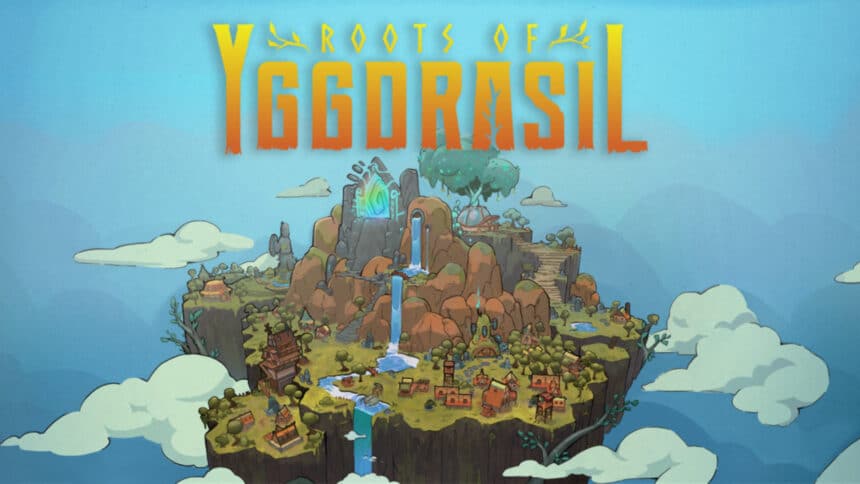Here’s a city-building puzzle game that’s taken me by surprise – Roots of Yggdrasil. As a mythology nerd and someone who would gladly choose Age of Mythology over Age of Empires any day for a dose of classic RTS gaming, ManaVoid Entertainment’s take on this genre has captured my attention in a way few games have.
Roots of Yggdrasil takes a unique approach, intertwining deck-building mechanics with city management, set in a never-ending time loop. While it may seem like a casual city builder on the surface, Roots of Yggdrasil reveals itself as a challenging puzzle game that demands both strategy and creativity.
Here are my first impressions of Roots of Yggdrasil.
Graphics

The character art style in Roots of Yggdrasil immediately reminded me of Tribes of Midgard, on the other hand, the building designs are somewhat inspired by Dorfromantik with the difference being that the models are larger and more detailed. I also love the card designs where I felt like i was playing a real tabletop game.

Even if you don’t own a high-spec machine, this game runs seamlessly, and I didn’t run into any performance issues.
Gameplay Loop

Roots of Yggdrasil feels like something you can spend hours playing or something you can dive into for a few runs. Each run will last you around 30 minutes to an hour or even more if you’re meticulous about your building placements. With procedurally generated puzzles, the environments you encounter provide a decent amount of challenge to keep things fresh.

Initially, I feared it might be an endless puzzle pursuit, reminiscent of Dorfromantik’s open-ended quest mechanics to reach the highest score. However, Roots of Yggdrasil does end at a certain point, letting you rest easy when you’ve completed a single run.
Deck-Building & Resource Mechanics
Each expedition (or Loop, as the game calls it) starts with a set of cards, with each card corresponding to a resource. For instance, building Sturdy Housing increases your population by 1 while increasing the cost by 1 Supply. As you progress, more complex cards like the Barracks and Markets come into play, introducing requirements that elevate the building challenge.

For example, placing a Barracks on the island map requires that it must be near a minimum of 3 Houses and you cannot place it near an existing Barracks. We can also see clearly that it’s a military-type building as shown on the card’s upper left corner along with its Supply cost and other required materials on the right side.

The introduction of Ginnungagap stood out to me. This magical void that represents an abyss of pure nothingness in Norse mythology adds a bit of suspense to the game, especially if you unlock the difficulty modifiers.
Map & Exploration

One of my first impressions of Roots of Yggdrasil when it comes to its world map exploration is that it takes a page from the Slay The Spire playbook. This element adds an extra layer of strategy and unpredictability, keeping you on your toes as you have options to find loot, power-ups, or even refine your deck before heading straight to the next loop.

You also have to be aware of how much time you have left before the Ginnungagap catches up to your ship and swallows you whole.
Roguelite Mechanics
After completing a Loop in Roots of Yggdrasil, the game extends beyond just a victory – it becomes an opportunity to enhance your deck/city-building experience.

Players can upgrade the Holt, the game’s central hub of operations which is pivotal for your progression. Cultivate Yggdrasil within the Holt using Lif’s Greenhouse where you can unlock cards and other power-ups for your next Loop expedition.

Thrasir’s Workshop enables you to add structures inside the Holt, giving you bonus resources to start with in future Loop expeditions.

Drawing inspiration from games like Hades, Roots of Yggdrasil also lets you add difficulty modifiers through Trials before starting a new Loop. For instance, setting a 30 to 60-second timer per turn lets you play under pressure, adding that extra challenge.
The Verdict

Roots of Yggdrasil is more than just a generic city-builder; it’s an immersive journey through mythology, freeform puzzles, and strategic city-building. Whether you’re a mythology enthusiast or a casual puzzle gamer, this charming tale to reach the end of Midgard is a must-play, offering a delightful blend of challenge and creativity.
And that wraps up our first impressions of Roots of Yggdrasil! If you’re interested in this game, feel free to get it on Steam.
This preview is based on the PC version of Roots of Yggdrasil. The key was provided by ManaVoid Entertainment.










